by Lisa Cooke | Mar 27, 2015 | 01 What's New, Canadian, Digital Archives, Military, Newspaper, Photographs
We learn about great new genealogy records online every week! On Fridays we round up a few for you. Watch for databases and documents that your  ancestors might appear in–and get inspired by the types of records that may be out there for your family, waiting for you to discover. This week: a photo archives for Canadian Mennonites, a Georgia state newspaper collection, a genealogy index for a northeast Ohio archive and WWII Cadet Nursing Corps membership cards (US).
ancestors might appear in–and get inspired by the types of records that may be out there for your family, waiting for you to discover. This week: a photo archives for Canadian Mennonites, a Georgia state newspaper collection, a genealogy index for a northeast Ohio archive and WWII Cadet Nursing Corps membership cards (US).
CANADIAN MENNONITE PHOTO ARCHIVE: A new database is now online with over 80,000 images of Mennonite life from across Canada and dating back to 1860s. A press release says that the archive “is a project of the Mennonite Historical Society of Canada and includes Mennonite archival partners in British Columbia, Alberta, Saskatchewan, Manitoba, and Ontario.” An online ordering system allows visitors to order image copies for noncommercial use.
GEORGIA NEWSPAPERS: The Digital Library of Georgia has launched an archive of north Georgia historical newspapers. “The North Georgia Historic Newspapers Archive provides online access to six newspaper titles published in three north Georgia cities (Dalton, Gainesville, and Rome) from 1850 to 1922. Consisting of over 33,000 newspaper pages, the archive provides historical images that are both full-text searchable and can be browsed by date. The site is compatible with all current browsers and the newspaper page images can be viewed without the use of plug-ins or additional software downloads. The archive includes the following north Georgia newspaper titles: Gainesville News (1902-1922), Georgia Cracker (Gainesville) (1894-1902), North Georgia Citizen (Dalton) (1868-1921), Rome Courier (1850-1855), Rome Tri-Weekly Courier (1860-1880), Rome Weekly Courier (1860-1878). The Digital Library of Georgia will add additional titles from the region over time.
OHIO GENEALOGY INDEX. The Western Reserve Historical Society in Cleveland, OH has created an online Genealogy Index to some of its most valuable and unique genealogical records, including original funeral home and Bible records. Also in the index are Jewish marriages and death notices, an index of names in a significant African-American manuscript collection, a 1907 Cleveland voter registration index, a photo database of Cleveland military personnel from WWII and the Korean War and a biographical sketch name index. Currently, there are about 320,000 records in the index; more are being added on an ongoing basis. The Society primarily archives records relating to Cleveland and northeast Ohio. Soon to be added are indexes to the 1870 mortality census for Ashtabula, Ohio and indexes to several church records collections.
WWII CADET NURSING CORPS (US): The WWII Cadet Nursing Corps Card Files, new on Fold3, contain membership cards of women who joined. According to Fold3, the cards “are organized by state, nursing school, and cadet name. Some cards include the date of admission to the school, date of admission to the corps, and date of graduation (or date of other reason for termination from the school). Others contain details like the woman’s marital status, father’s/husband’s name and profession, years of college completed, place of residence, and how they heard about the corps. Still others also record the woman’s age in addition to the previously mentioned information.”
 To search for images you can use without violating copyright, do a keyword search in Google Images (or just do a keyword search from Google’s home page and then click “Images” above your search results). Click Search Tools. Another toolbar will pop up. Click “Usage rights.” You can sort search results by those that are labeled for reuse in different ways. You won’t capture every copyright-free image, but hopefully you’ll get a decent selection of options! This tip comes to you courtesy of the book The Genealogist’s Google Toolbox, Second Edition by Lisa Louise Cooke–the fully-revised 2015 edition that’s packed with strategies that will dramatically improve your ability to find your family history online.
To search for images you can use without violating copyright, do a keyword search in Google Images (or just do a keyword search from Google’s home page and then click “Images” above your search results). Click Search Tools. Another toolbar will pop up. Click “Usage rights.” You can sort search results by those that are labeled for reuse in different ways. You won’t capture every copyright-free image, but hopefully you’ll get a decent selection of options! This tip comes to you courtesy of the book The Genealogist’s Google Toolbox, Second Edition by Lisa Louise Cooke–the fully-revised 2015 edition that’s packed with strategies that will dramatically improve your ability to find your family history online.
by Lisa Cooke | Feb 27, 2015 | 01 What's New, images, Maps
Do you have ancestors who lived in the “Windy City” of Chicago, Illinois (USA)? You should check out Chicago in Maps, a web portal to historic, current and thematic maps.
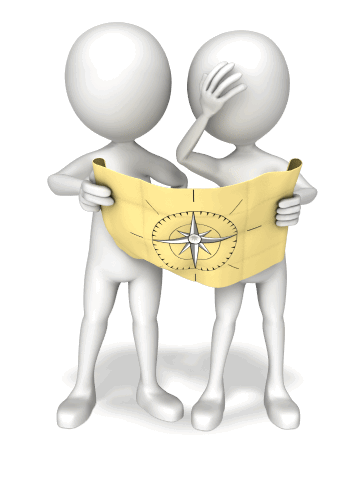
As the News-Gazette reports, “There are direct links to over three dozen historic maps of Chicago, from 1834 to 1921. The thematic maps include Chicago railroad maps, transit maps and geological maps.”
Of course, there are current maps, too, including a Chicago street guide for 2014. There’s a fascinating set of maps showing the effects of landfill projects. The Sources and Links page directs users to helpful guides to street name changes and house numbers. You’ll find links to surveyors’ maps, too.
From the home page, you can also click to a sister site on Chicago streetcars that includes a 1937 map of streetcar lines. (There’s a second sister site on Chicago bridges.)
Genealogy Gems Premium members can learn more about using maps for family history research in my online video class, 5 Ways to Enhance Your Genealogy Research with Old Maps. To learn more about the benefits of Premium membership (including a year’s full access to over 2 dozen full-length video classes), click here.
by Diahan Southard | Sep 25, 2012 | Genealogy Gems Podcast
In this episode we are pulling back the curtain on the Antiques Roadshow, as well as talking a bit about what to include and not include in your family tree.
I’m just back from Odessa Texas where I presented a full day seminar at the Permian Basin Genealogical Society. I got to enjoy a big dose of Texas hospitality and had an absolutely wonderful time.
Next up I’m heading to Kelowna British Columbia for the Kelowna & District Genealogical Society Harvest Your Family Tree 2012 Conference where I will be again doing four presentations as well as a Meet the Speakers panel.
MAILBOX:
Family Tree Magazine Digital Subscriptions from Kathy: “I subscribe to Family Tree Magazine. Can I download my print subscription to my iPad….as you can with other subscriptions? Or do I need to pay for each issue that I download? Family Chart Masters helped me with my Family Tree Chart. It was beautiful and was a hit at our Family Reunion. Janet was so helpful. Thank you for the recommendation. Love your podcasts.”
Lisa’s Answer: The Family Tree Magazine digital subscription is separate from the print subscription, unless you have purchase their VIP Subscription. So you can either purchase individual digital issues from the Shop Family Tree Store, or you can purchase a separate annual digital subscription. I think they keep it separate because not everyone wants both. Click here for a $10 off coupon for ShopFamilyTree and when you use that link it also supports the free Genealogy Gems Podcast. Thank you!
Get Lisa’s Book Turn Your iPad into a Genealogy Powerhouse
Paperback
Ebook
Replacement for RAOGK
From Mary in Iowa: “In Podcast #139, Ricky asked about a successor to the Random Acts of Genealogical Kindness website. There are actually three Facebook groups (not pages) carrying on the task of looking up genealogy information and other requests. They are RAOGK, RAOGK – USA, and RAOGK – International. You need to be a member of the Facebook group to post a message or request, but most requests for membership are granted quickly.”
Generous Genealogists
Gen Gathering
Scott from Oakland Maine: “I am in need of some advice regarding an un-cooperative family member. My father’s brother wants nothing to do with our family, and in years past once referred to himself as the “black sheep”. He has absolutely no interest in genealogy and is not at all willing to be a part of the family story that I am putting together. My question is, how do I reference this character in my tree.”
Lisa’s Answer: I imagine every family has a tough nut on a branch of the family tree! I’m a firm believer in the truth, and what I would do if it were me is to include basic data (that is publicly available) on him on my private, personal family tree. On trees and other info you make available publicly, (such as an online family tree) I would list him and his immediate family only as “Living” and whether they are male or female. In the end you have to do what seems right for you.
From Glenn: “Just wanted to say a quick thanks for both podcasts you produce…I’ve been interested in the Family History for some time…Recently my interest has arisen again, of course I have made classic mistake in not documenting everything, and just collecting names, dates and so forth. So in the last 6 months I’ve been citing sources and updating the database. One of the quandaries I have is when do you stop, not so much vertically, but how wide do you go, in relation to cousins, second cousins and families? Probably the main question I have is trying to decide whether to get a subscription to Ancestry.com or not, I feel I’m at that stage where online document will help out, in filling in the leaves on my branches.”
Lisa’s Answer: Go as wide as you want and are interested in. I would recommend adding basic info for someone you find who you won’t be pursuing, so that if down the road you run in to a brick wall and you need to do some cluster research or reverse genealogy, you will have new leads to follow. RE: Ancestry – I think you will find that Ancestry membership is a very cost effective and time saving way to do your research. Mine has been invaluable. See if you can find a 7 day free trial to check it out and confirm they have the kinds of records you need.
GEM: Diane Haddad Pulls Back the Curtain on The Antiques Roadshow
Music in this segment:
The Antiques Roadshow Remix
By The Elusive MrHatchard
Available on the SoundClick.com website
GEM: Halloween History Tidbits
Halloween Mason Jar Lanterns
Vampire Hunting Kit from the 1800s
GEM: Newspaper Milestones
On September 15, 1982, USA Today began publishing
On September 18, 1851, the New York Times issued its first edition
On September 25, 1690, the first newspaper in America was published for one day in Boston before being shut down by British authorities unhappy with its content.
Check out this episode
by Lisa Cooke | Sep 16, 2013 | 01 What's New, Ancestry, Who Do You Think You Are?
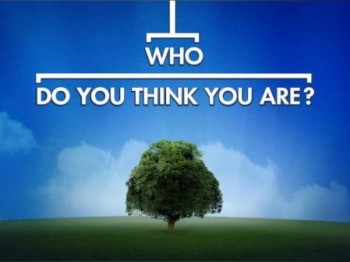 The final episode of TLC’s first season of Who Do You Think You Are? came with more than just an extra helping of ancestral drama. Along with the end of the season came the welcome announcement that WDYTYA? will return in 2014 on TLC.
The final episode of TLC’s first season of Who Do You Think You Are? came with more than just an extra helping of ancestral drama. Along with the end of the season came the welcome announcement that WDYTYA? will return in 2014 on TLC.
First, the final episode recap: American actor Jim Parsons explored his paternal line and discovered one ancestor who was lost in a tragic accident–and another who narrowly escaped death by guillotine.
The Ancestry.com research team reports, “When we went digging into Jim Parsons’ family tree we found his third-great-grandfather was Jean Baptiste Hacker, a phy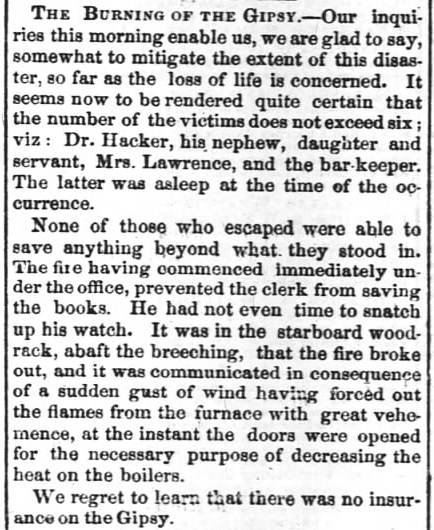 sician who was raised in New Orleans but moved to Plaquemine, Louisiana, after starting his medical career. Just a few years later, Dr. Hacker, along with his daughter Leocadie and his nephew, was killed in a tragic fire on board the steamboat Gipsy in December 1854.”
sician who was raised in New Orleans but moved to Plaquemine, Louisiana, after starting his medical career. Just a few years later, Dr. Hacker, along with his daughter Leocadie and his nephew, was killed in a tragic fire on board the steamboat Gipsy in December 1854.”
They documented the accident through an article from New Orleans paper the Daily Picayune (digitized at Newspapers.com and shown here):
Another line of research takes Jim’s ancestry back to France, where he learned one of his forebears was an architect to Louis XV. “The timing of Louis Francois [Trouard]’s appointment is significant: 1787 is only two years prior to the French Revolution. Four architects were executed during the Revolution, and another 25 were imprisoned. Yet Louis Francois escaped Republican retribution….”
“At the Chapelle de la Providence, a structure designed by his ancestor, Jim discovers the startling truth: Louis Francois had good revolutionary credentials, including houseguests such as Benjamin Franklin and John Adams.”
Along with that riveting last episode, TLC just announced it will bring back more of the same next season. On September 10, Digital Spy reported that 2014 will see 10 more episodes. Celebrity guests haven’t been announced yet, so stay tuned! We’ll keep you posted on future developments.
Meanwhile, TV watchers, mark your calendars for the American version of Genealogy Roadshow, the PBS show scheduled to debut next week.
by Lisa Cooke | Jan 7, 2014 | 01 What's New, History, Maps
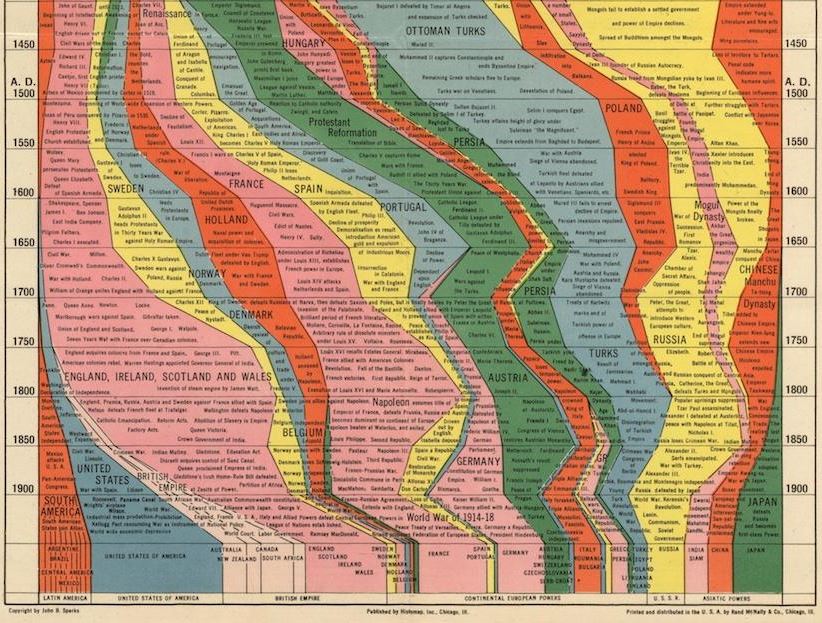
Partial image of Histomap of World History from Slate.com.
This might be the single most ambitious publication EVER: a chart that lays out the history of human civilization. It’s the ultimate infographic, created long before the era of the infographic!
What you see here is a partial image, a screenshot taken from a cool article on the 1931 Histomap: Four Thousand Years of World History.
It’s not perfectly accurate, it carries some cultural biases and ignorance of much of Africa’s rich history and the dates are given more as a range than anything. So what makes this a useful tool for genealogists?
We’re always looking for historical context: a way to understand how our ancestors fit into the “big picture” of history. Are you learning about a Portuguese or French line in your family? Learning by DNA tests that you have some deep Asian roots? Find these categories displayed on the map along with other dominant (or not-so-dominant) groups of your ancestor’s era. It’s cool to look at! Check out the entire map (and an explanatory post in this post by Rebecca Onion at Slate.com.
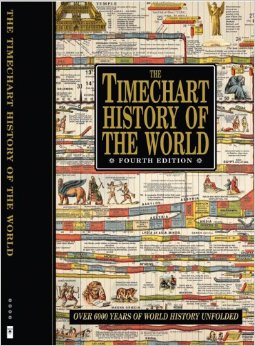 Genealogy Gems Contributing Editor Sunny Morton owns a book with a similar chart in it: Timechart History of the World (Timechart series)
Genealogy Gems Contributing Editor Sunny Morton owns a book with a similar chart in it: Timechart History of the World (Timechart series)
The Timechart History of the World. The oversize, double-sided stiff cardboard pages fold out to more than 30 feet of full-color Victorian-decorated timecharts. She highly recommends it for the coffee table, if your coffee table is big enough to handle it!
Bonus: The Huffington Post has a neat article (with a photo) of another map from this series,The Histomap of Religion. (Time Chart of World Religion: A Histomap of Faith Through the Ages ) Religions can be tough to trace forward over time, as various sects divide or merge. Every tool helps!
) Religions can be tough to trace forward over time, as various sects divide or merge. Every tool helps!
 ancestors might appear in–and get inspired by the types of records that may be out there for your family, waiting for you to discover. This week: a photo archives for Canadian Mennonites, a Georgia state newspaper collection, a genealogy index for a northeast Ohio archive and WWII Cadet Nursing Corps membership cards (US).
ancestors might appear in–and get inspired by the types of records that may be out there for your family, waiting for you to discover. This week: a photo archives for Canadian Mennonites, a Georgia state newspaper collection, a genealogy index for a northeast Ohio archive and WWII Cadet Nursing Corps membership cards (US). To search for images you can use without violating copyright, do a keyword search in Google Images (or just do a keyword search from Google’s home page and then click “Images” above your search results). Click Search Tools. Another toolbar will pop up. Click “Usage rights.” You can sort search results by those that are labeled for reuse in different ways. You won’t capture every copyright-free image, but hopefully you’ll get a decent selection of options! This tip comes to you courtesy of the book The Genealogist’s Google Toolbox, Second Edition by Lisa Louise Cooke–the fully-revised 2015 edition that’s packed with strategies that will dramatically improve your ability to find your family history online.
To search for images you can use without violating copyright, do a keyword search in Google Images (or just do a keyword search from Google’s home page and then click “Images” above your search results). Click Search Tools. Another toolbar will pop up. Click “Usage rights.” You can sort search results by those that are labeled for reuse in different ways. You won’t capture every copyright-free image, but hopefully you’ll get a decent selection of options! This tip comes to you courtesy of the book The Genealogist’s Google Toolbox, Second Edition by Lisa Louise Cooke–the fully-revised 2015 edition that’s packed with strategies that will dramatically improve your ability to find your family history online.




